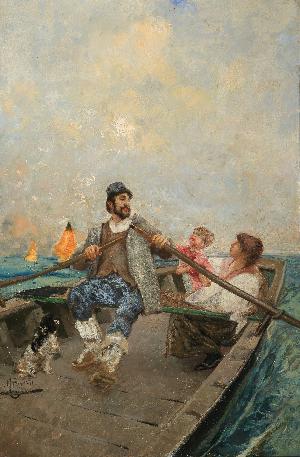BIANCHI MOSÈ
MONZA (MI) 1840 - 1904
Born in Monza on 13 October 1840 and died in the same city on 15 March 1904. He enters the Brera Academy at the age of sixteen, where he studies architectural drawing with the Viennese Federico Schmidt, scenography and perspective with Luigi Bisi, drawing and ornamentation with Giuseppe Sogni and Leandro Bernacchi, and landscape with the Austrian Albert Zimmermann. Here he has as companions Tranquillo Cremona, Daniele Ranzoni, Filippo Carcano and the two "Ticino" Antonio Barzaghi Cattaneo and Ernesto Fontana with whom he will share, from 1862, the studio in Via San Primo in Milan. After participating in the Second War of Independence, from 1863 he followed the chair of painting of Bertini who succeeded Hayez. His first essays are portraits, now in the Civic Museums of Monza, and paintings of historical and popular subjects, exhibited in Brera between 1862 and 1866: Archpriest Stefano Guandeca accusing the Archbishop of Milan, Anselmo Pusterla, of sacrilegious betrayal, The Pontina conspiracy, The communion of San Luigi and The eve of the festival, which opens the series of altar boys who will subsequently acquire full autonomy with A good smoke of 1872 (Milan, Giovanni Treccani degli Alfieri Collection), which he won the Principe Umberto Prize in 1877. The first version of Cleopatra emerged in 1865, astonishing nude from life, and the first version of La Signora di Monza, with a more pronounced psychological focus on the character. He concludes his first Milanese period with Saul's Vision (1866), obtaining the Pensionato Oggioni from the Brera Academy which allows him to travel for two years in the cities of art, from Florence to Rome to Venice, where he studies the colorism of Giambattista Tiepolo, up to Paris, where he came into contact with the neo-eighteenth-century painting of Jean-Louis-Ernest Messonier and Mariano Fortuny. In his full maturity, in addition to themes from Dante or inspired by the novel Cento Anni by Giuseppe Rovani, a dear friend of the painter (Painter Londonio and the lost Colloquio del Galantino with Donna Clelia), he also dedicates himself to subjects drawn from contemporary life, such as The Reader (1867) and Fratelli al campo (1869), both in the Brera Art Gallery, Blessing of the houses and Church exit (1870), the interior of the Cathedral of Monza, exhibited in Brera in 1874 and purchased by the King of Belgium, Return from the festival of 1877 (Milan, Gallery of modern art), which inaugurate that interior trend of the church that culminates with The word of God of 1887 (Rome, National Gallery of Modern Art). In the portrait he stands out from his early early works, with the portraits of his nephew and later favorite pupil Pompeo Mariani (1868-1870 circa), and with the masterful Portrait of a noble gentleman, in which he depicts his father, with whom he won the Prince Prize in 1874 Umberto (who will be awarded again in 1900 with an Interno di casolare in Gignese and in 1904 with The departure for the duel). Eclectic and versatile painter, in addition to watercolor and etching (in 1896 he won a prize at the National Chalcography Competition) he also experimented with the fresco decorating the Villa Giovanelli in Lonigo, near Vicenza (1877), the room of the Monza railway station ( 1883) and Palazzo Turati in Milan (1885). Since 1879 he has dealt with subjects set in the Venetian lagoon, especially in Chioggia (for example, Port of San Felice in Chioggia and Traversata in Laguna, both from 1885 and kept at the Gallery of Modern Art in Milan), which alternates with Lombard views taken in the long stays in Gignese, on Lake Maggiore, and in characteristic images of Milanese life, mostly at night and in winter. In 1898 he won the competition for professor and director of the Cignaroli Academy in Verona, and moved to Villa Berengario, in the Tascherio village. He will only stay there for a year. At the end of 1899 he returned to Monza where he died on March 15, 1904. Two years later an exhibition was dedicated to him as part of the Universal Exposition in Milan.
©2015 ENRICO Gallerie d'Arte - All Right Reserved - P.IVA 00985970094 | Privacy Policy | Cookie Policy | Site Map

